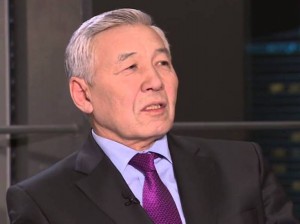 ALMATY – For the first time in the history of Central Asia and the Commonwealth of Independent States, UNESCO held an international conference on the problem of earthquake mitigation in late May in Almaty. Director of the Institute of Seismology of the National Scientific and Technological Holding Parasat, Doctor of Technical Sciences and Academician of the Kazakhstan National Academy of Natural Sciences Tanatkan Abakanov recently discussed its outcomes.
ALMATY – For the first time in the history of Central Asia and the Commonwealth of Independent States, UNESCO held an international conference on the problem of earthquake mitigation in late May in Almaty. Director of the Institute of Seismology of the National Scientific and Technological Holding Parasat, Doctor of Technical Sciences and Academician of the Kazakhstan National Academy of Natural Sciences Tanatkan Abakanov recently discussed its outcomes.
What is the forum’s significance for the international image of Kazakhstan?
The forum, planned by the UN and included in the action plan of the international cooperation of the Ministry of Education and Science of Kazakhstan, has great importance for Kazakhstan’s image in the eyes of the world public. We hope it will provide a real mechanism for attracting foreign investors in the construction industry in seismically active areas in Kazakhstan. The forum gathered more than 20 world-renowned scientists from all over the world in addition to domestic experts.
The result of the work is creating conditions to attract new scientific methods and technologies in Kazakhstan, the UN proposals to the Government of Kazakhstan to mitigate consequences of devastating earthquake if it takes place in our country, including Almaty, as well as providing timely effective international assistance. The participants of the forum adopted a resolution which is compulsive for all countries with a strong threat of destructive earthquakes.
You have said that special attention in the document is paid to the seismic safety of Kazakhstan…
Absolutely correct. The forum recommended increasing the network of seismological observations by two times in comparison with the currently existing monitoring (to open 52 new seismic stations in Kazakhstan). There is a need to create a special international experimental centre in the Almaty region for the study of seismic processes and the seismic resistance of construction projects.
Also it is recommended to ensure constant geodynamic and engineering monitoring of the manmade environment of the nuclear, oil and gas industries and mining and metallurgical complexes, as well as hydro-technical facilities in Kazakhstan. No less important is to provide the basic seismic stability of social infrastructure, life support systems, including educational and residential objects located in the earthquake-prone regions.
What caused the increased interest of the international community to the problem of seismic safety?
The matter is that the world has entered the next phase of global seismic activity. This is evidenced by the devastating earthquakes in Japan (in 1995 and 2011), Turkey (1999), Afghanistan (2002), Iran (2003), China (2003, 2008), Indonesia (2004 and 2009) and other countries. The process of intensive seismic activity will continue up to 2025 and affect Kazakhstan.
Speaking about the problem of manmade earthquakes’ genesis, it should be noted that in the 20th century, strong and catastrophic earthquakes took place in oil and gas fields. Sensible earthquakes also began on the hydrocarbon deposits in Kazakhstan. As it is known, there are 214 hydrocarbon fields in western Kazakhstan, 81 of which are under development, and only two deposits are monitored. Large hydraulic structures also provoke strong and destructive earthquakes. Currently, Kazakhstan has erected such hydraulic systems as Bukhtarma, Ust-Kamenogorsk, Shulbinsk, Kapshagai and others. All of them are located in the areas of high seismic risk. But none of these objects, as far as we know, has the seismological monitoring of areas with water reservoirs.
Actually the problem of seismic safety in Kazakhstan is multi-faceted and complex.
Of course, and here we can separate the main directions of activity: the forecast and monitoring of earthquakes, the assessment of seismic hazards (mapping of seismic zones of different details, assessment and mitigation of seismic risk of settlements and industrial enterprises, ensuring seismic safety of strategic facilities, such as nuclear power plants, hydroelectric power stations, waterworks, oil and gas, mining and metallurgical complexes).
It’s worth mentioning that the problems of seismic safety are paramount for all countries that are located in regions of high seismic intensity. In this context, UNESCO conducts consolidating works. Thus, the Hyogo Declaration, which emphasised the importance of strengthening cooperation between the countries in this connection, was adopted in 2005 at the World Conference to reduce consequences of disasters held under the auspices of UNESCO in Japan. UNESCO’s determination was reflected in the programme of the International Platform for Reducing Earthquake Disasters, which was adopted for implementation in 2008 and will continue in the future. In 2012, our Institute of Seismology was officially registered by UNESCO among nine countries which conduct intensively research of seismic safety.
What can you say about the situation in our city?
As known, the most seismically active area in Central Asia is the territory of Zaili Alatau, where Almaty is located. Therefore, the issues of earthquake prediction, assessment of seismic hazard and provision for the seismic stability of the national economy are fundamental in addressing the problem of seismic safety of the city. Results of the earthquakes’ analysis show that early organisational and engineering activities and reliable management of people at the threat of earthquakes and liquidation of its consequences greatly reduce losses of life and material damage.
In general, the power structures and media should pay particular attention to preparation and training of the population for earthquakes. An illustrative example is the experience of Japan, where moral and psychological preparation is introduced in all preschools, schools, higher education institutions, organisations and enterprises. Also, we need a good education TV programme on the seismic protection of the population.


